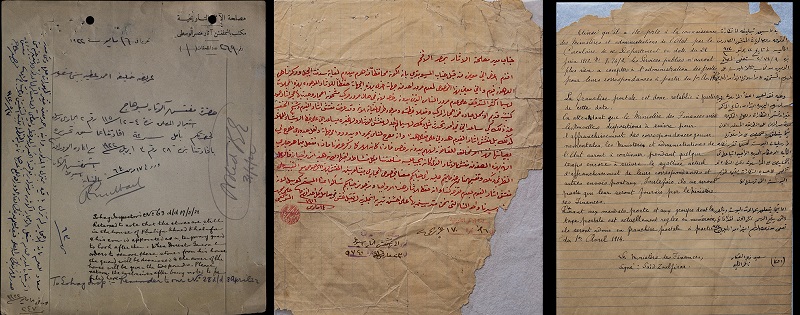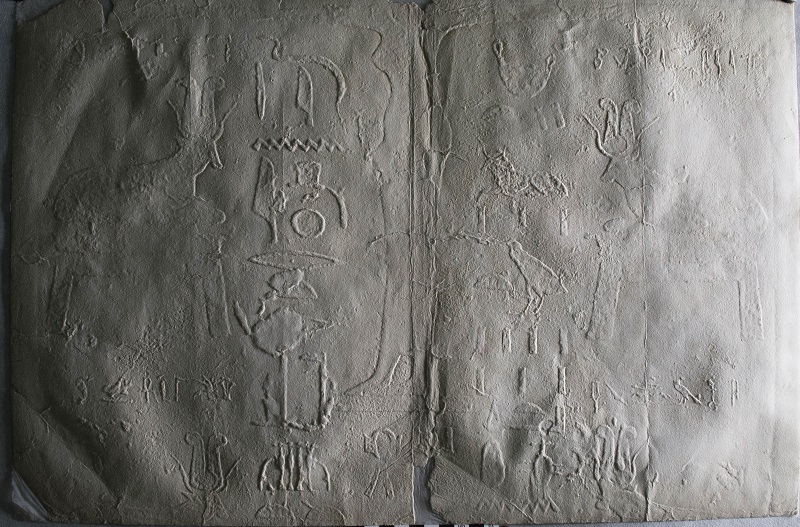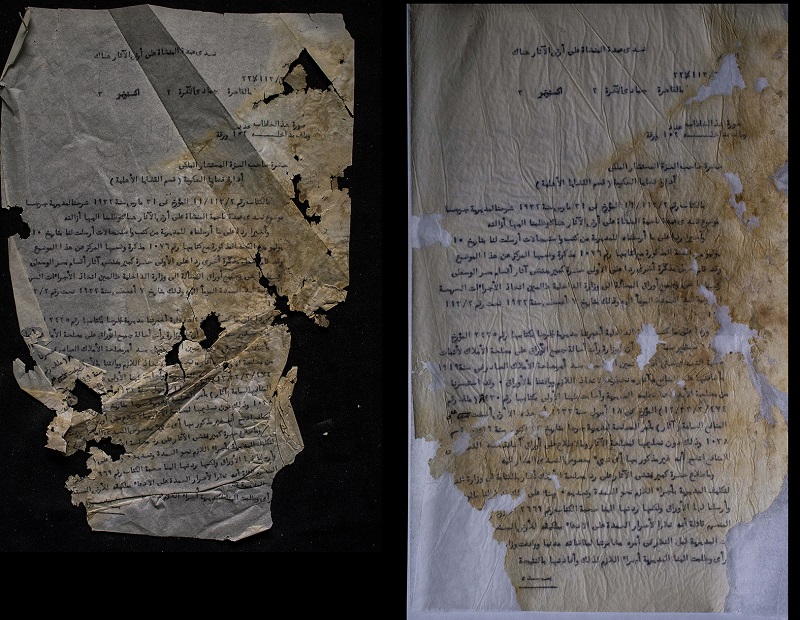- EraModern
- Project DirectorNora Shalaby
- LocationAbydos
- AffiliationUniversity of CaliforniaBerkeley
- Project SponsorAntiquities Endowment Fund
- Project Dates2016-2017
In 2013, when Abydos inspector Ayman Damarany reopened a long-sealed chamber in the slaughterhouse area of the Grand Temple of Seti I, he expected to fulfill his assignment to record the decorations on the walls. But he was instead surprised to find the room filled with thousands of documents, many tied up in bundles along the walls and others strewn across the floor.
Damarany had found a depository belonging to the Sohag Inspectorate and the broader Egyptian Antiquities Service, with documents – mostly in Arabic – written by employees of the Antiquities Authority from as early as the 1820s. The reams of records included correspondence, excavation reports and survey maps made long before the landscape around the Abydos site took its current form. To organize and preserve the archive, Ayman put together an Egyptian-led international team with members from the Ministry of State for Antiquities, the United States and Europe.
The significance of this trove was quickly recognized for its potential to enhance not only the modern history of one of ancient Egypt’s most revered sites but also the explorations of locations further afield. More importantly, and for the first time, the early history of Egyptology could be examined from the viewpoint of Egyptians rather than the lens of foreign missions.
This archive comprises a unique collection related to the early history of Egyptology and is currently the only known one of its kind. Before being deposited in the slaughterhouse, these papers, maps and other documents had passed through the hands of the local workers and officials responsible for the management of Abydos and other sites in its vicinity over the recent past. Now, by preserving this precious archive – and making it available to the public – the Abydos Temple Paper Archive aims to provide a more inclusive account of the development of early Egyptology. The project restores the voices of many Egyptian employees of the Antiquities Service who were critical players in bringing to light the history and heritage of ancient Egypt and who are, until now, a long-neglected part of Egypt’s cultural heritage.
The archive project is an Egyptian-American mission under the auspices of the Ministry of State for Antiquities and the University of California, Berkeley, with support from the Antiquities Endowment Fund, administered through ARCE and with the permission of the Permanent Committee of Egyptian Antiquities.
The range of documents at the team’s disposal, originally prepared or administered by the Egyptian Antiquities Service, are both diverse and distinct: official correspondence between inspectorates, administrations or ministries; unofficial notices or even complaints from guards or employees of the Ministry of Antiquities; and memos with new or updated instructions, especially during times of unrest, hardship or political change. For example, early office ledgers of the inspectorates disclose how Egyptians managed, documented, researched and protected the sites. Some entries record the confiscation of stolen artifacts, trespassing on antiquities land and arguments between guards and village leaders.
The inaugural season of work, from April through June 2017, had a daunting goal: to rescue and assess the most precious of the documents, especially those strewn on the floor, and to begin the painstaking labors of sorting and conservation. Those tasks were followed by the mundane but critical chores of restoration, copying, digitizing, transcribing and translating, and filing of all of the documents.
The records vary from bureaucratic to historic. One example is a file comprising the monthly inspection reports for 1968-69 by Dorothy Eady, the famous Abydos gadfly-expert better known as “Omm Seti.” Another file contained the collected records of famed Egyptian scholar Labib Habachi, one of the first Egyptology graduates from Cairo University (1928), who worked for the Antiquities Department for over 30 years. Many of the documents highlight the extent of the influence Egyptian heritage workers had in the antiquities’ service, even at a time when the institution was still led by the French and dominated by the British. The documents show that Egyptian scholars and excavators, contrary to the prevailing narrative, actively engaged with their heritage and wielded influence over foreign scholars.
To protect project documents and preserve them for future generations, conserved documents were placed in acid-free boxes on custom aluminum shelves in our workspace. Another important step, of course, is the one that eventually will allow researchers not only in Egypt but worldwide to view, study and use the Abydos archive. That comes through the custom database designed for easy searches by topics, themes, areas and/or people mentioned in the documents.


